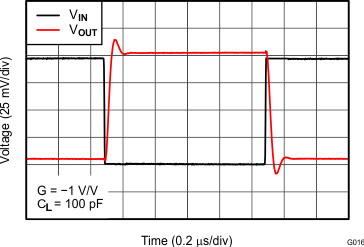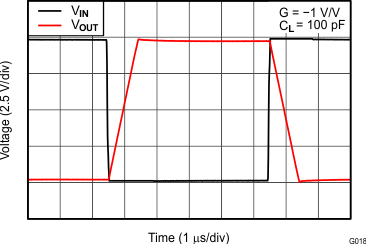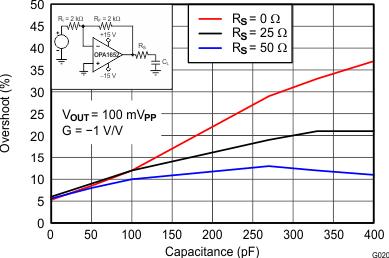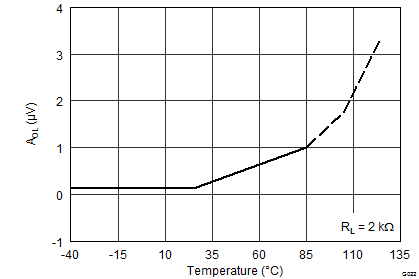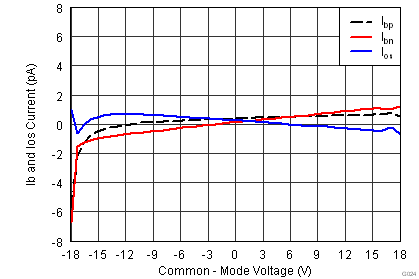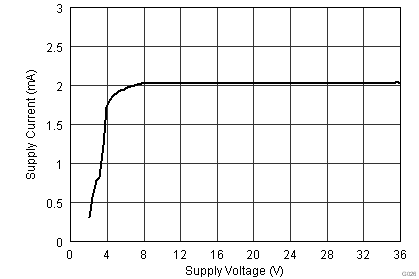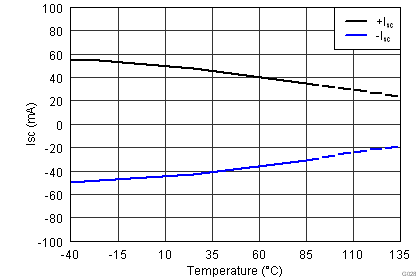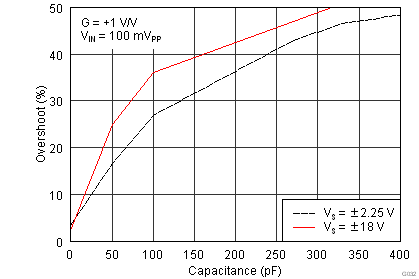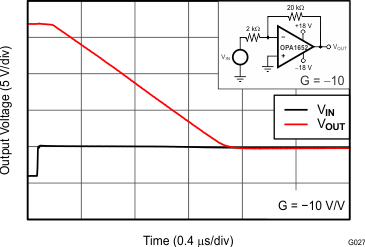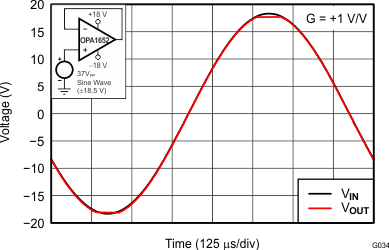ZHCS618B December 2011 – December 2016 OPA1652 , OPA1654
PRODUCTION DATA.
- 1 特性
- 2 应用
- 3 说明
- 4 修订历史记录
- 5 Pin Configuration and Functions
- 6 Specifications
- 7 Detailed Description
- 8 Application and Implementation
- 9 Power Supply Recommendations
- 10Layout
- 11器件和文档支持
- 12机械、封装和可订购信息
封装选项
机械数据 (封装 | 引脚)
散热焊盘机械数据 (封装 | 引脚)
- DRG|8
订购信息
6 Specifications
6.1 Absolute Maximum Ratings
over operating free-air temperature range (unless otherwise noted)(1)| MIN | MAX | UNIT | ||
|---|---|---|---|---|
| Voltage | Supply voltage, VS = (V+) – (V–) | 40 | V | |
| Input | (V–) – 0.5 | (V+) + 0.5 | V | |
| Current | Input (all pins except power-supply pins) | –10 | 10 | mA |
| Output short-circuit(2) | Continuous | |||
| Temperature | Operating, TA | –55 | 125 | °C |
| Junction, TJ | 200 | °C | ||
| Storage, Tstg | –65 | 150 | °C | |
(1) Stresses beyond those listed under Absolute Maximum Ratings may cause permanent damage to the device. These are stress ratings only, which do not imply functional operation of the device at these or any other conditions beyond those indicated under Recommended Operating Conditions. Exposure to absolute-maximum-rated conditions for extended periods may affect device reliability.
(2) Short-circuit to VS / 2 (ground in symmetrical dual supply setups), one amplifier per package.
6.2 ESD Ratings
| VALUE | UNIT | |||
|---|---|---|---|---|
| V(ESD) | Electrostatic discharge | Human-body model (HBM), per ANSI/ESDA/JEDEC JS-001(1) | ±2000 | V |
| Charged-device model (CDM), per JEDEC specification JESD22-C101(2) | ±1000 | |||
| Machine model (MM) | ±200 | |||
(1) JEDEC document JEP155 states that 500-V HBM allows safe manufacturing with a standard ESD control process.
(2) JEDEC document JEP157 states that 250-V CDM allows safe manufacturing with a standard ESD control process.
6.3 Recommended Operating Conditions
over operating free-air temperature range (unless otherwise noted)| MIN | NOM | MAX | UNIT | ||
|---|---|---|---|---|---|
| Supply voltage | 4.5 (±2.25) | 36 (±18) | V | ||
| TA | Operating temperature | –40 | 85 | °C | |
6.4 Thermal Information: OPA1652
| THERMAL METRIC(1) | OPA1652 | UNIT | |||
|---|---|---|---|---|---|
| D (SOIC) | DGK (VSSOP) | DRG (WSON) | |||
| 8 PINS | 8 PINS | 8 PINS | |||
| RθJA | Junction-to-ambient thermal resistance | 143.6 | 218.9 | 66.9 | °C/W |
| RθJC(top) | Junction-to-case (top) thermal resistance | 76.9 | 78.6 | 54.5 | °C/W |
| RθJB | Junction-to-board thermal resistance | 61.8 | 103.7 | 40.4 | °C/W |
| ψJT | Junction-to-top characterization parameter | 27.8 | 14.6 | 1.9 | °C/W |
| ψJB | Junction-to-board characterization parameter | 61.3 | 101.8 | 40.4 | °C/W |
| RθJC(bot) | Junction-to-case (bottom) thermal resistance | N/A | N/A | 10.8 | °C/W |
(1) For more information about traditional and new thermal metrics, see the Semiconductor and IC Package Thermal Metrics application report.
6.5 Thermal Information: OPA1654
| THERMAL METRIC(1) | OPA1654 | UNIT | ||
|---|---|---|---|---|
| D (SOIC) | PW (TSSOP) | |||
| 14 PINS | 14 PINS | |||
| RθJA | Junction-to-ambient thermal resistance | 90.1 | 126.9 | °C/W |
| RθJC(top) | Junction-to-case (top) thermal resistance | 54.8 | 46.6 | °C/W |
| RθJB | Junction-to-board thermal resistance | 44.4 | 58.6 | °C/W |
| ψJT | Junction-to-top characterization parameter | 19.9 | 5.5 | °C/W |
| ψJB | Junction-to-board characterization parameter | 44.2 | 57.8 | °C/W |
| RθJC(bot) | Junction-to-case (bottom) thermal resistance | N/A | N/A | °C/W |
(1) For more information about traditional and new thermal metrics, see the Semiconductor and IC Package Thermal Metrics application report.
6.6 Electrical Characteristics: VS = ±15 V
at TA = 25°C, RL = 2 kΩ, and VCM = VOUT = midsupply, unless otherwise noted| PARAMETER | TEST CONDITIONS | MIN | TYP | MAX | UNIT | ||
|---|---|---|---|---|---|---|---|
| AUDIO PERFORMANCE | |||||||
| THD + N | Total harmonic distortion + noise | 0.00005% | |||||
| G = 1, f = 1 kHz, VO = 3 VRMS | –126 | dB | |||||
| IMD | Intermodulation distortion | G = 1, VO = 3 VRMS |
SMPTE and DIN Two-Tone, 4:1 (60 Hz and 7 kHz) |
0.00005% | |||
| –126 | dB | ||||||
| DIM 30 (3-kHz square wave and 15-kHz sine wave) | 0.00005% | ||||||
| –126 | dB | ||||||
| CCIF Twin-Tone (19 kHz and 20 kHz) |
0.00005% | ||||||
| –126 | dB | ||||||
| FREQUENCY RESPONSE | |||||||
| GBW | Gain-bandwidth product | G = 1 | 18 | MHz | |||
| SR | Slew rate | G = –1 | 10 | V/µs | |||
| Full power bandwidth(1) | VO = 1 VP | 1.6 | MHz | ||||
| Overload recovery time | G = –10 | 1 | µs | ||||
| Channel separation (dual and quad) | f = 1 kHz | –120 | dB | ||||
| NOISE | |||||||
| en | Input voltage noise | f = 20 Hz to 20 kHz | 4.0 | µVPP | |||
| Input voltage noise density | f = 1 kHz | 4.5 | nV/√Hz | ||||
| f = 10 kHz | 3.8 | nV/√Hz | |||||
| In | Input current noise density | f = 1 kHz | 3 | fA/√Hz | |||
| OFFSET VOLTAGE | |||||||
| VOS | Input offset voltage | VS = ±2.25 V to ±18 V | ±0.5 | ±1.5 | mV | ||
| VS = ±2.25 V to ±18 V, TA = –40°C to 85°C(2) | 2 | 8 | µV/°C | ||||
| PSRR | Power-supply rejection ratio | VS = ±2..25 V to ±18 V | 3 | 8 | µV/V | ||
| INPUT BIAS CURRENT | |||||||
| IB | Input bias current | VCM = 0 V | ±10 | ±100 | pA | ||
| IOS | Input offset current | VCM = 0 V | ±10 | ±100 | pA | ||
| INPUT VOLTAGE RANGE | |||||||
| VCM | Common-mode voltage range | (V–) + 0.5 | (V+) – 2 | V | |||
| CMRR | Common-mode rejection ratio | 100 | 110 | dB | |||
| INPUT IMPEDANCE | |||||||
| Differential | 100 || 6 | MΩ || pF | |||||
| Common-mode | 6000 || 2 | GΩ || pF | |||||
| OPEN-LOOP GAIN | |||||||
| AOL | Open-loop voltage gain | (V–) + 0.8 V ≤ VO ≤ (V+) – 0.8 V, RL = 2 kΩ | 106 | 114 | dB | ||
| OUTPUT | |||||||
| VOUT | Voltage output | RL = 2 kΩ | (V–) + 0.8 | (V+) – 0.8 | V | ||
| IOUT | Output current | See Typical Characteristics | mA | ||||
| ZO | Open-loop output impedance | f = 1 MHz | See Typical Characteristics | Ω | |||
| ISC | Short-circuit current(3) | ±50 | mA | ||||
| CLOAD | Capacitive load drive | 100 | pF | ||||
| POWER SUPPLY | |||||||
| VS | Specified voltage | ±2.25 | ±18 | V | |||
| IQ | Quiescent current (per channel) |
IOUT = 0 A | 2 | 2.5 | mA | ||
| IOUT = 0 A, TA = –40°C to 85°C(2) | 2.8 | mA | |||||
| TEMPERATURE | |||||||
| Specified range | –40 | 85 | °C | ||||
| Operating range | –55 | 125 | °C | ||||
(1) Full-power bandwidth = SR / (2π × VP), where SR = slew rate.
(2) Specified by design and characterization.
(3) One channel at a time.
6.7 Typical Characteristics
at TA = 25°C, VS = ±15 V, and RL = 2 kΩ, unless otherwise noted.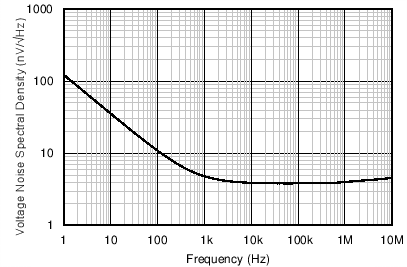
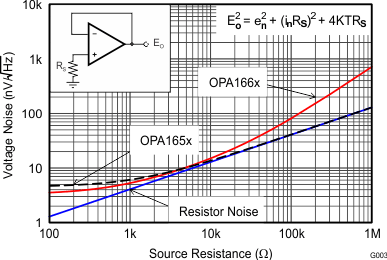
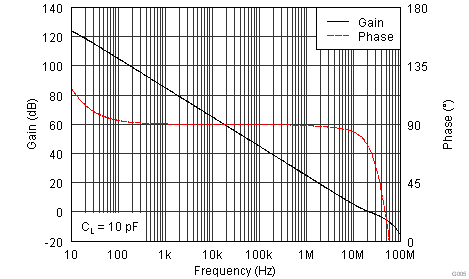
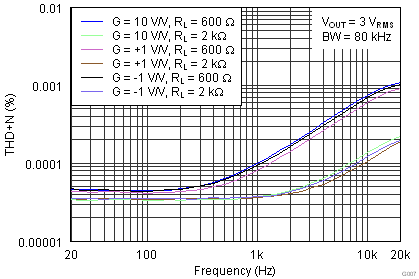
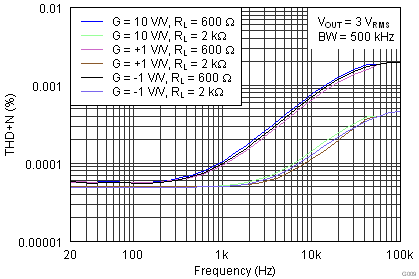
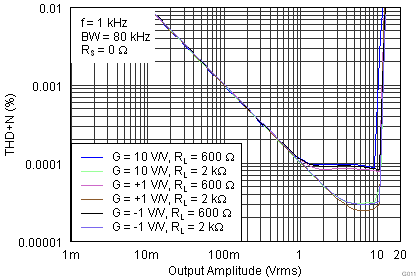
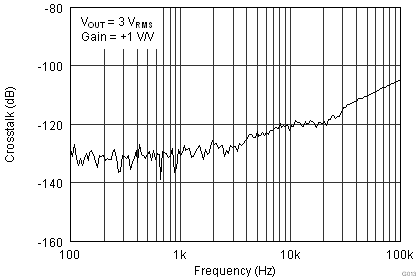
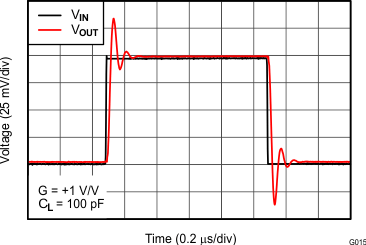
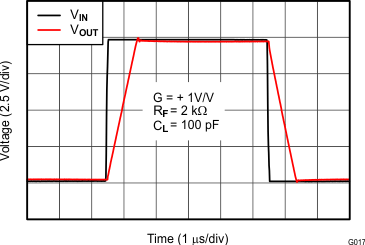
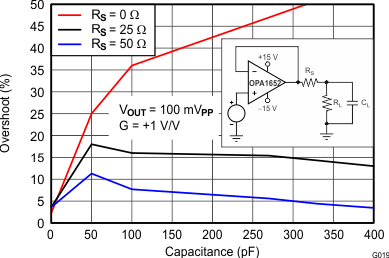
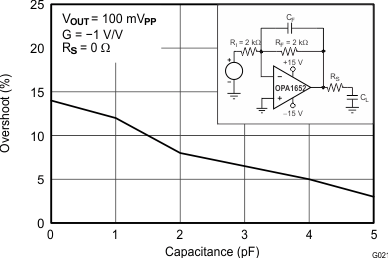
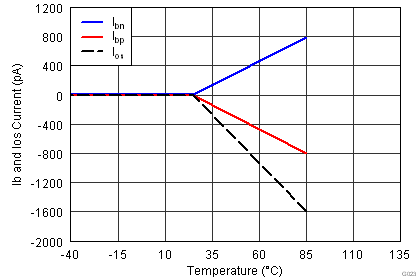
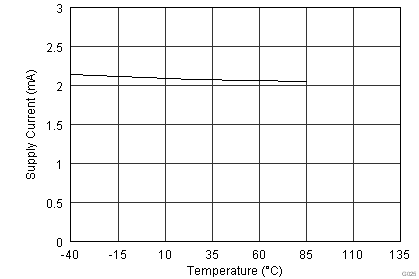
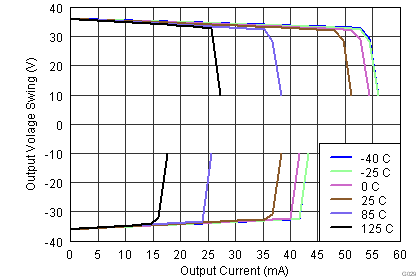
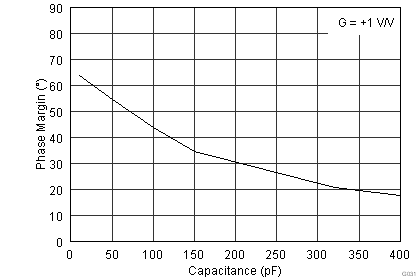
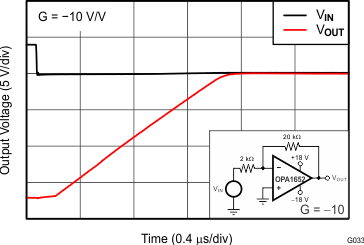
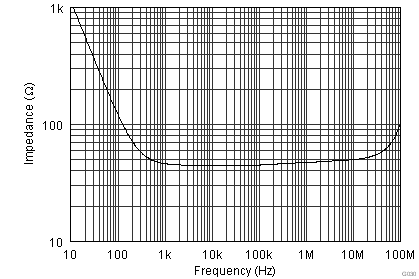
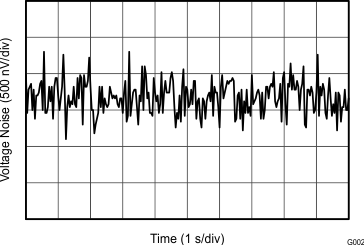
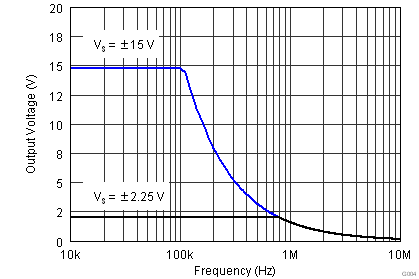
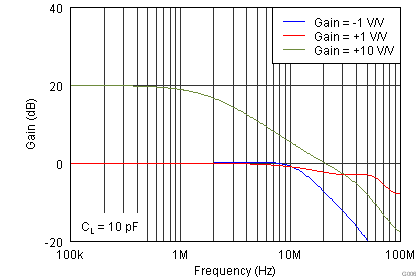
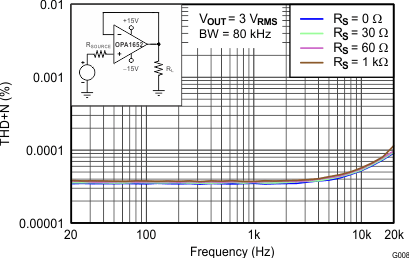
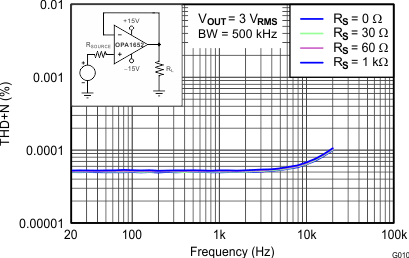
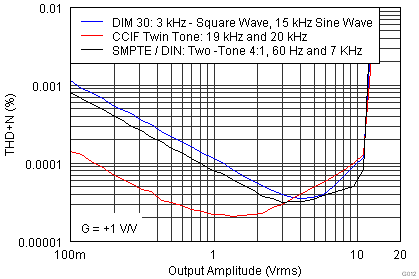
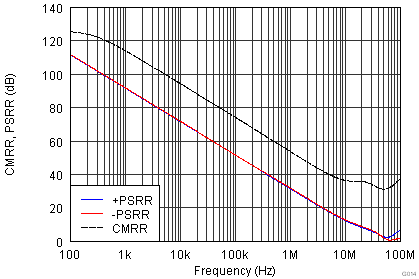
(Referred to Input)
